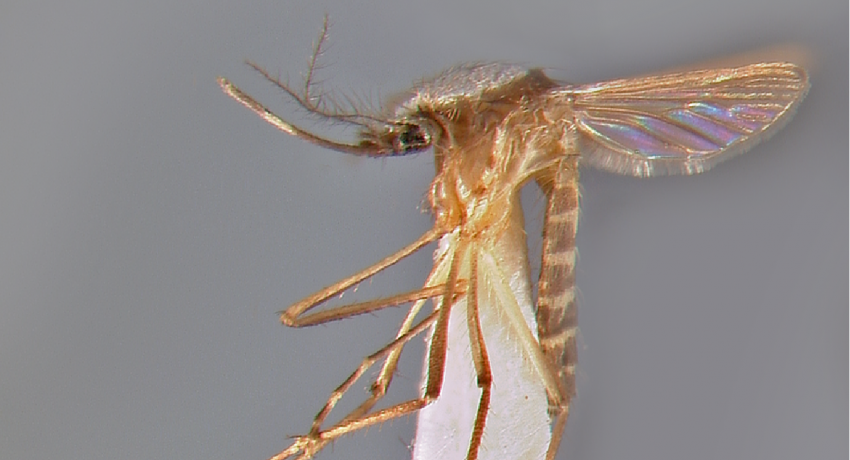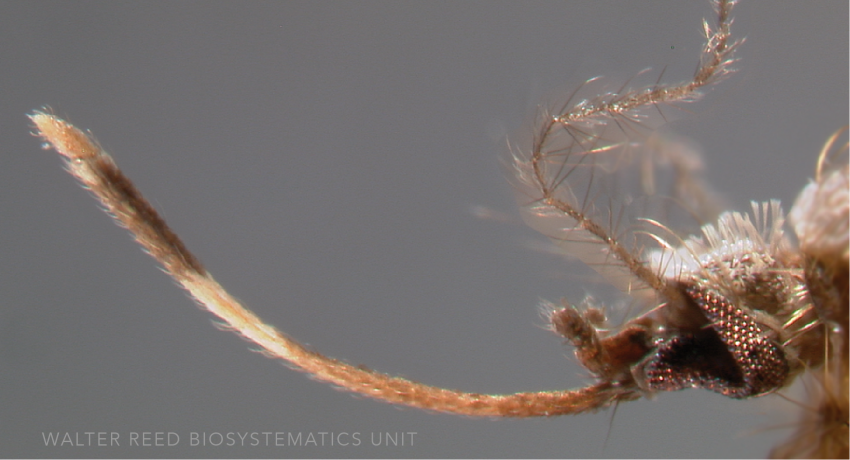ORIENTAL REGION
[AUSTRALASIAN & PALAEARCTIC]
Informal name: Icy Malaysian Typical Mosquito
Etymology: ice cold (L); refers to frosty-white scale on the head and scutum
Adult Cx. gelidus has a distinct white-scaled scutum and broad pale banding on the proboscis. It is the sole member of the Gelidus Subgroup (Gelidus Group), and has two valid subspecies—cuneatus Theobald and cuneatus Theobald. Populations of this efficient vector have notably increased he past decade, particularly in urban and suburban areas, giving cause for concern.
Type locality: Selangor, Malaya [Malaysia]
Type depository: Natural History Museum, London, England, United Kingdom (NHMUK)
DIAGNOSTIC CHARACTERS (Click photos to view; mouse over and click large photo to zoom in.)
ADULT (illustrated): Head: Proboscis with broad median pale band; vertex with erect white scales. Thorax: Distinct double row of acrostichal setae present; scutum white-scaled anterior to prescutellar area; pleuron with distinct scale patches; lower mesepimeral setae absent. Legs: Ta-I–III with pale bands at articulations; Fe-II,III without pale speckling on anterior surfaces. Abdomen: Terga with broad basal pale bands.
LARVA (not illustrated): Head: Seta 1-C distinct, pointed; dorsal apotome distinctly separated from median labral plate. Terminal segments: Siphon short, expanded medially; dorsal surface of siphon smooth, without a strong subapical spine dorsally; anal papillae longer than saddle.
TAXONOMIC KEYS
Lee et al. 1989a
Darsie & Pradhan 1990
Rattanarithikul et al. 2005
![]()
WRBU – Culex (Cux.) – Indomalayan Region – Larva
Exemplar DNA sequences
Cx. gelidus COI: HQ398892, HQ398894–95
BIONOMICS
Immatures
Culex gelidus utilizes a wide variety of oviposition sites and adapts quickly to new environments. Immatures inhabit temporary and semi-permanent water sources such as rice fields, ground pools, stream pools, small streams, freshwater swamps, and tires. In recent years, populations of this efficient vector species have notably increased, particularly in urban and suburban areas, in several countries. Its native range, it occupies the clean natural water habitats; in new territories, where it is considered invasive, it can also be found in water with high levels of organic matter, including wastewater treatment plant holding tanks, agriculture seepage pools, barrels, and tanks.
Adults
Peak biting of female Cx. gelidus occurs in the early morning before dawn (03:00–06:00). Adults are vicious biters, preferring to feed on large domestic animals such as cows, horses, and pigs. In the absence of domestic livestock, this species readily feeds on humans, and wild birds, chickens, goats, and deer.
DISTRIBUTION NOTES
Bangladesh, Cambodia, India, Indonesia, Japan, Laos, Malaysia, Myanmar, Nepal, Pakistan, Papua New Guinea, People’s Republic of China (includes Hong Kong), Philippines, Singapore, Sri Lanka, Taiwan, Thailand, Vietnam.

WRBU VECTOR HAZARD REPORTS
None; View other WRBU Vector Hazard Reports
Available GIS Models
IMPORTANT REFERENCES (full citations below)
Theobald 1901c: 20 (F*)
Barraud 1924m (L*)
Barraud 1934: 407 (M*, F, L*)
Baisas 1938: 213 (M*, F, P*, L*)
Bonne-Wepster 1954: 119 (M, F*, L*)
Bram 1967b: 247 (M*, F*, P*, L*; bionomics, taxonomy, distribution)
Aslamkhan 1971b (distribution; Pakistan)
Basio 1971b: 56 (M*; bionomics)
Berlin & Subramanian 1974: 263 (E*)
Baisas 1974: 92 (M, F, P, L; taxonomy, bionomics, distribution; Philippines)
Sirivanakarn 1976: 58 (M*, F*, P*, L*)
Ahmed 1987 (distribution; Bangladesh)
Lee et al. 1989a: 122 (F key, taxonomy, bionomics, distribution, review)
Darsie & Pradhan 1990 (F, L; taxonomy, keys, bionomics, distribution; Nepal)
Rattanarithikul et al. 2005 (F*, L*; bionomics, distribution, keys; Thailand)
CURRENT SYNONYMS
syn. cuneatus Theobald
1901c: 22 (F*; as var.). Type locality: Taipang, Perak, Malaya [Malaysia] & Quilon, Travancore, India (NHMUK).
syn. bipunctata Theobald
1907: 374 (M; Leucomyia; as var.). Type locality: India & Sarawak [Malaysian Borneo] (NHMUK).
CITED REFERENCES
Ahmed, T.U. (1987). Checklist of the mosquitoes of Bangladesh. Mosquito Systematics, 19(3), 187–200.
Aslamkhan, M. (1971b). The mosquitoes of Pakistan I. A checklist. Mosquito Systematics, 3(4), 147–159.
Baisas, F. E. (1938). Notes on Philippine mosquitoes. VII. A. Culex (Culex) with banded proboscis and tarsi. B. Anopheles: the pupae of three rare species; the Leucosphyrus-subgroup. Monthly Bulletin of the Bureau of Health, 18(5), 175–232.
Baisas, F. E. (1974). The mosquito fauna of Subic Bay Naval Reservation, Republic of the Philippines. San Francisco: Headquarters, First Medical Service Wing (PACAF), San Francisco.
Barraud, P. J. (1924m). A revision of the culicine mosquitoes of India. Part XVII. Indian Journal of Medical Research (Calcutta), 12, 427–434.
Barraud, P. J. (1934). The fauna of British India, including Ceylon and Burma. Diptera. Vol. 5. Family Culicidae, tribes Megarhinini and Culicini. London: Taylor and Francis.
Basio, R. G. (1971b). The mosquito fauna of the Philippines (Diptera, Culicidae). Manila: National Museum of the Philippines. 198pp.
Berlin, O.G.W., & Subramanian, M. (1974). Description of the egg of Culex (Culex) gelidus Theobald with a note on development (Diptera, Culicidae). Mosquito Systematics, 6(4), 263–265.
Bonne-Wepster, J. (1954). Synopsis of a hundred common non-anopheline mosquitoes of the Greater and Lesser Sundas, the Moluccas and New Guinea. Documenta de Medicina Geographica et Tropica, 6, 1–29.
Bram, R.A. (1967b). Contributions to the mosquito fauna of Southeast Asia. II. The genus Culex in Thailand (Diptera: Culicidae). Contributions of the American Entomological Institute, 2(1), 1–296.
Darsie, R.F., Jr., & Pradhan, S.P. (1990). The mosquitoes of Nepal: Their identification, distribution and biology. Mosquito Systematics, 22(2), 69–130.
Lee, D.J., Hicks, M.M., Debenham, M.L., Griffiths, M., Marks, E.N., Bryan, J.H., & Russell, R.C. (1989a). The Culicidae of the Australasian region. Volume 7. Commonwealth Department of Health, School of Public Health and Tropical Medicine Monograph Series, 2.
Rattanarithikul, R., Harrison, B.A., Panthusiri, P., & Coleman, R.E. (2005). Illustrated keys to the mosquitoes of Thailand. I. Background; geographic distribution; lists of genera, subgenera, and species; and a key to the genera. Southeast Asian Journal of Tropical Medicine and Public Health, 36(1), 1–80.
Sirivanakarn, S. (1976). Medical entomology studies - III. A revision of the subgenus Culex in the Oriental region (Diptera: Culicidae). Contributions of the American Entomological Institute, 12(2), 1–272.
Theobald, F.V. (1901c). A monograph of the Culicidae or mosquitoes (Vol. 2). London: British Museum (Natural History). with Atlas of 37 colored pls. + 5 pls. of photographs.
Theobald, F.V. (1907). A monograph of the Culicidae of the world (Vol. IV). London.
CITE THIS PAGE
Walter Reed Biosystematics Unit (Year). Culex gelidus species page. Walter Reed Biosystematics Unit Website, http://wrbu.si.edu/vectorspecies/mosquitoes/gelidus, accessed on [date (e.g. 03 February 2020) when you last viewed the site].











































































































































































